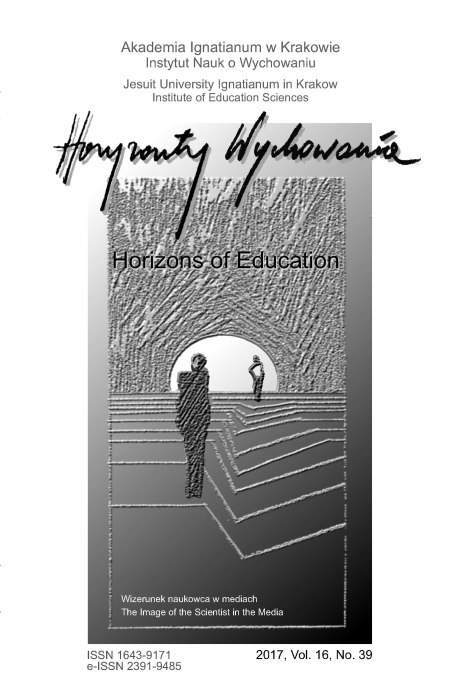Narcissistic attitudes among scientists
Abstract
PURPOSE OF RESEARCH: The purpose of this article is to identify the causes of narcissistic attitudes observable among academics. The author draws attention to sourcesof the both types of the narcissism : an endogenous and an exogenous.
PROBLEM AND RESEARCH METHODS: Research issues presented in this article are exploratory. They come to attempt to answer the question: Which endogenous and exogenous factors play a dominant role in shaping the narcissistic attitudes of academic teachers? The research method is based on literature studies, nut also based on exploration, description, and also attempts to explain the analyzed phenomenon.
REASONING PROCESS: The article consists of five main parts. The first of these presents the specificity symbolic violence typical for the didactics. Next presents the criteria for the diagnosis of narcissism and mechanisms of commodification of scientists. Attention was also drawn to the recognition treated as an indicator of the scientific position and the processes associated with the omnipotence of the master.
SCIENTIFIC ANALYSIS RESULTS: The author indicates that in the case of narcissism observable among scientists we have to deal with a number of factors both endo- and egogenous that determine its prevalence among scientists.
CONCLUSIONS, INNOVATIONS, RECOMMENDATIONS: Presented phenomenon is practically absent in the Polish scientific discourse concerning the sphere of science. Some attempts to unmask the work of academics can be found at Pierre Bourdieu's, but they areReferences
Aldridge, A. (2006). Konsumpcja. Warszawa: Sic!
Bourdieu, P. (2006). Medytacje pascaliańskie. Warszawa.
Bourdieu, P. (2009). O telewizji. Panowanie dziennikarstwa. Warszawa: Wydawnictwo Naukowe PWN.
Bourdieu, P. i J.C. Passeron. (2011). Reprodukcja. Warszawa: Wydawnictwo Naukowe PWN.
Debray, R. (2010). Wprowadzenie do mediologii. Warszawa: Oficyna Naukowa.
Godzic, W. (2007). Znani z tego, że są znani. Celebryci w kulturze tabloidów. Warszawa: WAiP.
Goffman, E. (1981). Człowiek w teatrze życia codziennego. Warszawa: Państwowy Instytut Wydawniczy.
Golińska, L. (2008). Pracoholizm. Uzależnienie czy pasja. Warszawa: Difin.
Halpern, J. (2007). Fame Junkies: The Hidden Truths Behind America’s Favorite Addiction. Boston New York: Mifflin Company.
Horney, K. (1999). Neurotyczna osobowość naszych czasów. Poznań: Rebis. Lynn M. i C.R. Snyder. (2002). Uniqueness seeking. W: C.R. Snyder i S.J. Lopez (red.). Handbook of positive psychology. Nowy Jork: Oxford University Press.
Morf, C. i Rhodewalt, F. (2001). Unraveling the paradoxes of narcissism: A dynamic self-regulatory processing model. Psychological Inquiry, 12.
Olchanowski, T. i Sieradzan, J. (2011). Wprowadzenie do problematyki narcyzmu. Od klasycznych koncepcji narcyzmu do narcyzmu kultury zachodniej. W: J. Sieradzan (red.), Narcyzm. Jednostka, społeczeństwo, kultura. Białystok: Wydawnictwo Uniwersytetu w Białymstoku.
Oltmanns, T.F., Friedman, J., Fiedler, E. i Turkheimer, E. (2004). Perceptions of people with personality disorders based on thin slices of behavior. Journal of Research in Personality, 38.
Orlik, P. (2000). Rozum a wrażliwość. W: P. Orlik (red.), Rozdroża i ścieżki wrażliwości. Poznań: UAM.
Paulhus, D.L. (1998). Interpersonal and intrapsychic adaptiveness of trait selfenhancement: A mixed blessing? Journal of Personality and Social Psychology, 74.
Szpunar, M. (2012). Nowe-stare medium. Internet między tworzeniem modeli komunikacyjnych a reprodukowaniem schematów komunikowania masowego. Warszawa: IFiS PAN.
Szpunar, M. (2015). Mediatyzacja nauki. O roli naukowców w epoce paleo- i neo-telewizji Zarządzanie w Kulturze, 3, 293-301.
Szpunar, M. (2016). Kultura cyfrowego narcyzmu. Kraków: Wydawnictwo AGH.
Sztompka, P. (1999). Merton Robert King. W: H. Domański i Z. Bokszański (red.), Encyklopedia socjologii. T. 3. Warszawa: Oficyna Naukowa.
Thompson, J. (2001). Media i nowoczesność. Społeczna teoria mediów. Wrocław: Astrum.
Thornton, B., Lovely, A., Ryckman, R. i Gold, J. (2009). Playing Dumb and Knowing It All: Competitive Orientation and Impression Management Strategies. Individual Difrerences Research, 7(4).
Turner, R.H. (1971). Sponsored and Contest Mobility and the School System.
W: E. Hopper (red.), Readings in the Theory of Educational Systems. London.
Wielecki, K. (2003). Podmiotowość w dobie kryzysu. Między indywidualizmem a kolektywizmem. Warszawa: Centrum Europejskie Uniwersytetu Warszawskiego.
Copyright (c) 2017 HORIZONS OF EDUCATION

This work is licensed under a Creative Commons Attribution-NonCommercial-NoDerivatives 4.0 International License.
Authors who publish in this journal agree to the following terms:
- Authors retain the copyright to their work while granting the journal the right of first publication. The work will be simultaneously licensed under a CC BY-ND license, which permits others to share the work with proper credit given to the author and the original publication in this journal.
- Authors may enter into additional, non-exclusive agreements for the distribution of the published version of the work (e.g., posting it in an institutional repository or publishing it in another journal), provided that the original publication in this journal is acknowledged.
We allow and encourage authors to share their work online (e.g., in institutional repositories or on personal websites) both before and during the submission process, as this can foster beneficial exchanges and lead to earlier and increased citations of the published work. (See The Effect of Open Access). We recommend using any of the following academic networking platforms:





